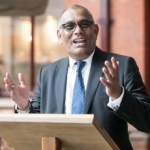Abstract:
What initially appeared as a spontaneous student movement in July 2025, grounded in education-related grievances, has since morphed into a multifaceted, ideologically charged upheaval. Beneath the surface lies a strategic alignment between disenchanted elite circles, ex-military officers, Islamist factions, and foreign backers. This paper examines the political architecture of the so-called July Revolution, tracing its shift from a legitimate protest into a symbolic insurrection reminiscent of a Bengali version of the French Revolution—one seemingly designed to erase the legacy of Bangladesh’s Liberation War and redirect the nation toward an Islamic-nationalist, post-secular political order. Through documented indicators, foreign visits, and ideological cues, we interrogate whether this revolution is truly about reform—or regime change by stealth.
1. From Tuition Fees to Revolution: The Forgotten Origins
The July Movement began not with grand ideology, but with economic frustration. It was spearheaded by students of private universities protesting against the imposition of Value Added Tax (VAT) and income tax on educational institutions. These policies had significantly increased tuition fees, making quality higher education inaccessible for many middle-class families.
Worse still, for many graduates, there were no jobs awaiting them, feeding resentment among the youth. Simultaneously, the abolition of the quota system in government jobs—once a lifeline for underprivileged and rural students—further fuelled discontent.
Initially, students took to the streets to demand affordability, employment, and fairness. But quickly, this organic protest was co-opted. A new narrative emerged—one no longer about fees and jobs, but about reimagining Bangladesh. The movement evolved into what some described as a Bengali rendition of the French Revolution, though to many observers, the symbolism, targets, and tone pointed not toward liberty, but toward erasure—of history, secular values, and the Liberation War itself.
2. The Backroom Engineers: Cadet Elites and the Discourse of ‘New Bangladesh’
A prominent and curious force behind the evolution of the protest was a network of ex-cadet college students. These institutions, established under Pakistan’s Ayub Khan, were elite boarding schools designed to create a loyal officer class, imbued with discipline, religious conservatism, and social hierarchy.
Today, their alumni dominate sections of the bureaucracy, military, judiciary, and private sector. These individuals began to influence the movement’s ideological framing. Their social media commentary and intellectual positioning projected an anti-establishment, anti-corruption message—but also sidestepped secular nationalism and instead emphasized Islamic heritage and order.
The “New Bangladesh” they espoused had little to do with the ideals of 1971, and much more in common with the authoritarian and military-centric vision of Pakistan’s own post-colonial statehood.
3. Ex-Military Shadows: A Coup Without Uniforms?
Unconfirmed reports and leaked online communications suggest that several retired military officers provided quiet logistical, moral, and possibly strategic support to the movement. These were not fringe elements but former mid- and high-level commanders, many of whom reportedly felt marginalised under the Awami League’s reshaped civil-military policy post-2009.
For them, this revolution was less about democracy and more about redressing power balances—reclaiming influence lost over the last decade, especially after the BDR mutiny and the civilian consolidation of intelligence and military command.
4. Jamaat and the Islamist Bloc: Silent Architects in the Shadows
Perhaps the most coordinated and rapid support came from Bangladesh’s Islamist parties. Jamaat-e-Islami, banned electorally but not ideologically, signaled its alignment early. Its student wing, Islami Chhatra Shibir, mobilised covertly on campuses and streets under neutral or borrowed banners. Their participation shifted the tone of the protests.
Soon, the language of the revolution subtly changed. Slogans previously aimed at fee reduction or job creation began to echo calls for “Islamic justice,” “cleansing of corrupt seculars,” and “liberation from Indian puppets.”
Groups like Hefazat-e-Islam, Khelafat Majlish, and others joined in, emboldened by the apparent vacuum of opposition leadership. Their goal? To bring down the secular-nationalist structure and replace it with a ‘moral’ Islamic state — a vision long held since their post-2013 rise.
5. BNP’s Lukewarm Nod: Riding the Wave, Avoiding the Blame
The BNP, wary of being accused of instigation, maintained a calculated distance from the leadership of the movement. However, their rank-and-file, especially in student and rural wings, played active roles in the mobilisation.
Their involvement added political muscle to the uprising but also deepened the ideological confusion. Was this a liberal reformist revolution or a reactionary Islamist realignment? BNP seemed happy to let both interpretations flourish, as long as it weakened the Awami League.
6. Foreign Imprints: Is Pakistan Pulling Strings Again?
Perhaps the most alarming undercurrent has been the subtle but visible return of Pakistan as a political actor in Bangladesh’s domestic sphere. Intelligence sources and media leaks suggest that at least three retired Bangladesh Army generals recently met with Pakistani military-linked operatives—either in third countries or during ‘coincidental’ travel overlaps.
The strategic objective is clear: to restore Islamic nationalism in Bangladesh and isolate India regionally. The parallels with 1975’s coup—when pro-Pakistan military officers overthrew the Mujib regime—are difficult to ignore.
7. China’s Calculated Embrace
Amid all this, another player looms large—China. Several Islamist party delegations have visited China under the guise of “development cooperation.” Yet analysts note a growing ideological alignment: China supports autocratic regimes so long as they are anti-India, anti-West, and economically pliable.
If Pakistan offers ideological and covert support, China offers legitimacy and infrastructure. Bangladesh may be stepping into the same model as Pakistan—foreign-funded growth with suppressed dissent and institutionalised religiosity.
8. Anti-India Rhetoric and the Erasure of 1971
One of the most disturbing features of the July movement has been its undercurrent of anti-India sentiment. The newly appointed Chief Advisor of the interim regime has, in multiple veiled references, questioned the relevance of India in Bangladesh’s birth and hinted at reevaluating ties with the “eastern hegemon.”
His controversial statement about the “Seven Sisters” of India being “trapped lands” was not just geopolitically provocative—it represented a historical betrayal. That a country created with India’s blood and support now hosts leadership openly deriding that history points to a seismic ideological shift.
Furthermore, some protest materials targeted national icons of the Liberation War—museums, murals, memorials—with graffiti and threats. The idea wasn’t just regime change. It was historical cleansing.
9. Journalists, Think Tanks, and Intellectual Drift
Several independent journalists and think tanks initially supported the movement as a democratic wave. But as the symbols and slogans changed, many were left bewildered. Few acknowledged publicly that what began as a student-led protest had been appropriated by forces with far more radical goals.
A disturbing silence now hangs over many media voices who once championed secularism and minority rights but now align—tacitly or actively—with Islamist-friendly rhetoric, often under the guise of “national unity” or “moral reform.”
10. Conclusion: A Revolution or a Coup in Disguise?
The July Movement of Bangladesh began as a legitimate, youth-led protest against education injustice, unemployment, and social exclusion. But what followed was a hijacking—first by elite ideological actors, then by Islamist strategists, and finally by opportunists with transnational ambitions.
The signs are clear: anti-secularism, anti-India posturing, Islamic revivalism, elite backing, and foreign encouragement from both Pakistan and China. Together, they point not to reform, but to regime reversal, identity reconstruction, and perhaps, a soft Talibanisation of Bangladesh.
The outcome may not be an immediate theocracy. But if this convergence of actors is not checked, Bangladesh could slowly become a hybrid state—part military-authoritarian, part religious-nationalist, fully detached from its foundational promise of pluralism, justice, and sovereignty earned through blood in 1971.
References:
-
The Daily Star, Editorials and Op-Eds (2024–2025)
-
Dhaka Tribune, “Cadet College Influence in Elite Politics” (2025)
-
The Diplomat, “Pakistan’s Strategic Re-entry into Bangladesh”
-
Indian Express, “India Concerned Over Dhaka’s Anti-Secular Drift” (2025)
-
Prothom Alo, Reports on Military Retiree Activity
-
Hefazat-e-Islam and Jamaat e Islami Social Media Statements (2024–2025)
-
Analysis from South Asia Policy Group (SAPG), London
-
Academic journal: Islamism & South Asia Studies Quarterly, Issue 1, 2025



